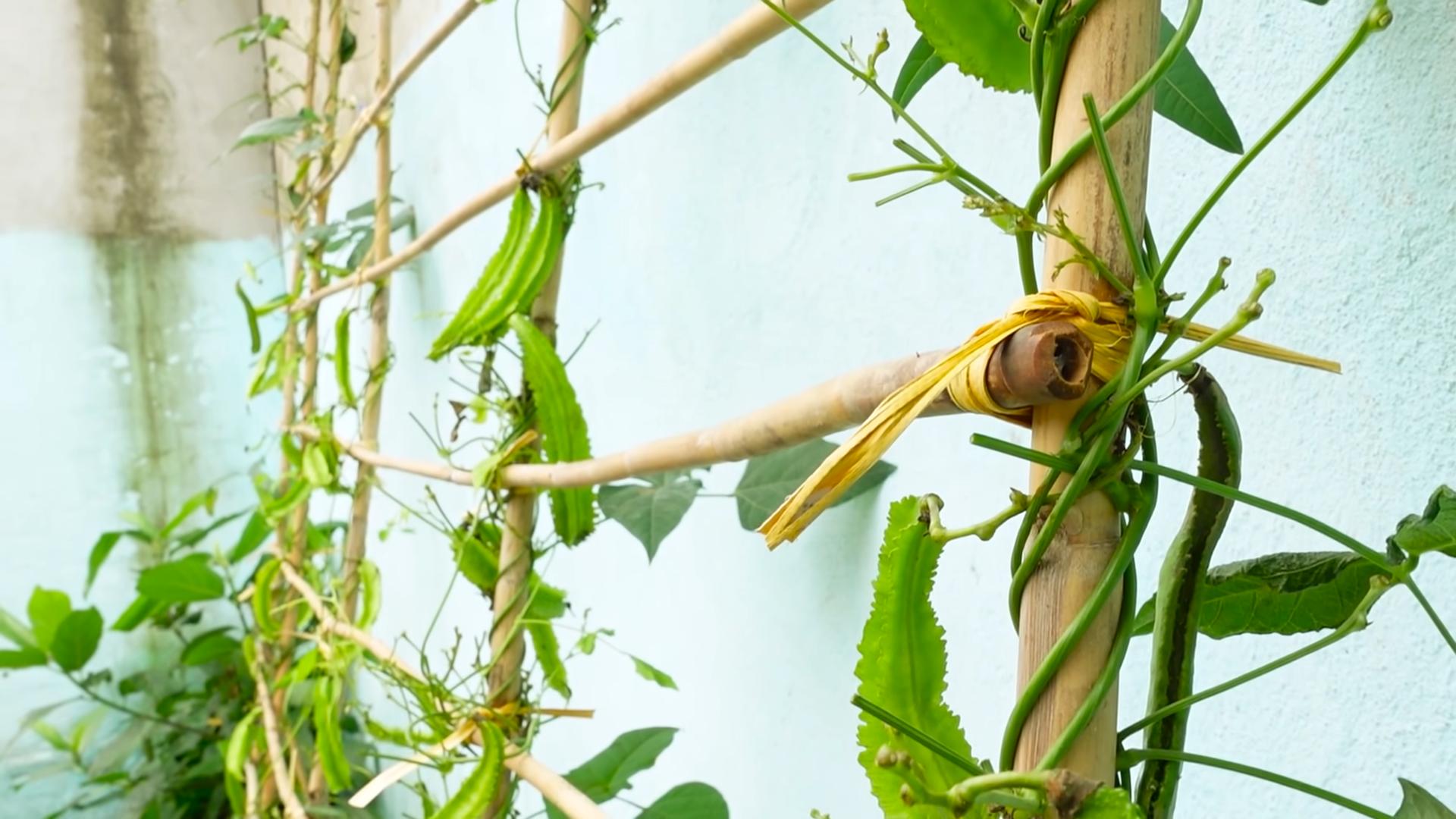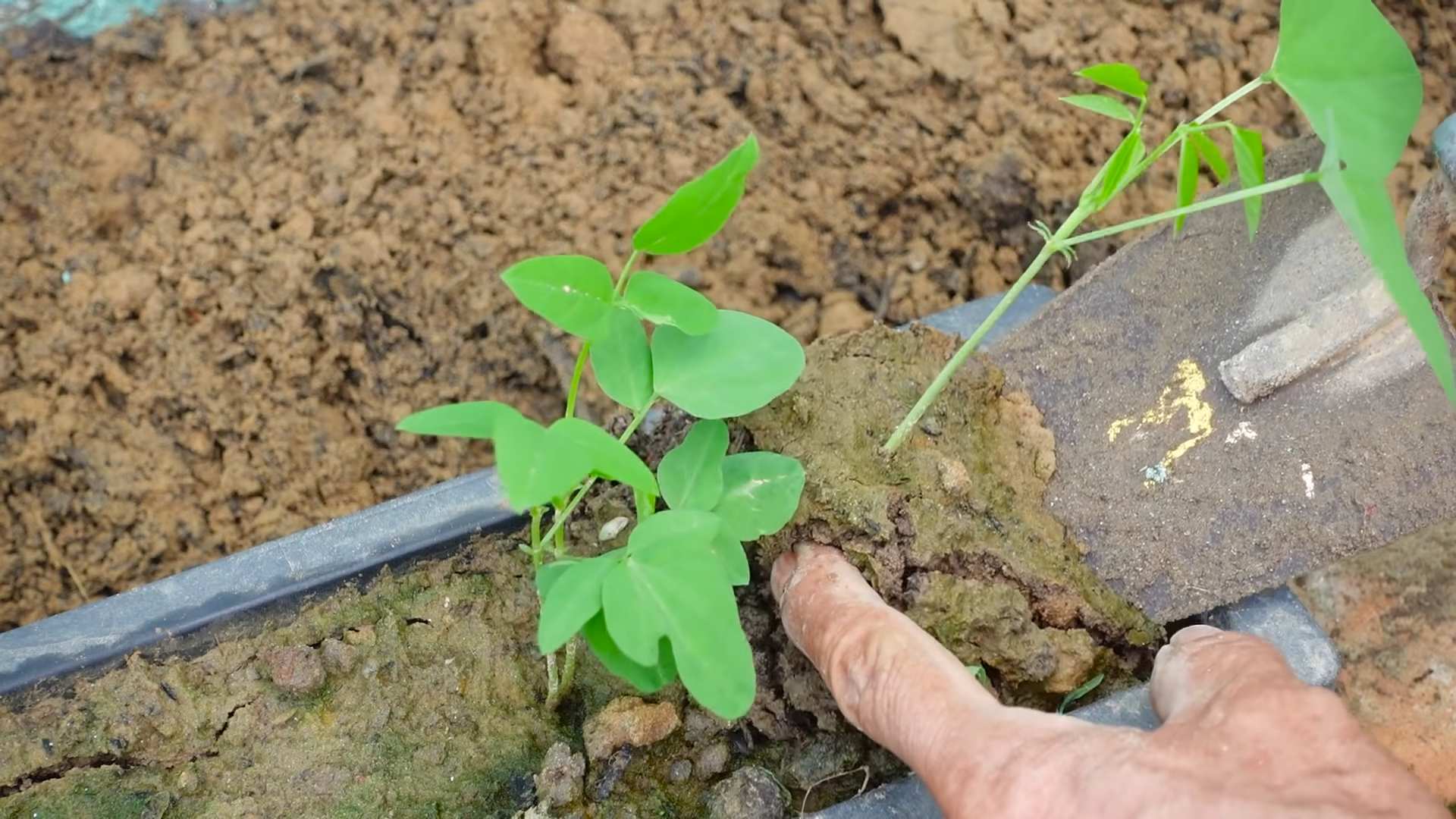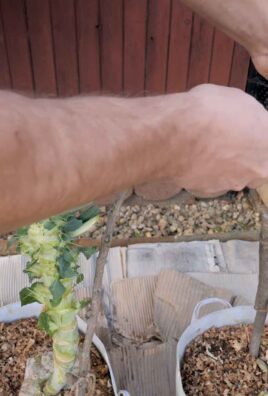Growing Dragon Beans might sound like something straight out of a fantasy novel, but trust me, it’s a real and rewarding experience you can have right in your own backyard! Have you ever dreamed of cultivating vibrant, exotic vegetables that not only taste amazing but also add a touch of magic to your garden? Well, look no further! This DIY guide is your key to unlocking the secrets of successfully growing these fascinating legumes.
While dragon beans, also known as asparagus beans or yardlong beans, may not have a deeply rooted historical significance like some other heirloom vegetables, their popularity has been steadily growing across various cultures, particularly in Asian cuisine. These beans are prized for their impressive length (sometimes reaching over a yard long!), their crisp texture, and their ability to absorb flavors beautifully in stir-fries, salads, and other dishes. I’ve personally found them to be a delightful addition to my garden and a conversation starter with friends and neighbors!
Why should you embark on this growing dragon beans adventure? Because it’s easier than you think, and the rewards are plentiful! Imagine harvesting fresh, flavorful beans right outside your door, knowing exactly where your food comes from and avoiding those pricey grocery store markups. Plus, these vigorous climbers are not only productive but also visually stunning, adding vertical interest and a touch of the extraordinary to any garden space. I’m here to guide you through every step, from seed to table, with simple, effective DIY tricks and hacks that will ensure a bountiful harvest. Let’s get started!

Growing Dragon Beans: A DIY Guide to a Bountiful Harvest
Hey there, fellow gardening enthusiasts! I’m so excited to share my experience growing dragon beans. These aren’t your average green beans; they’re long, vibrant, and absolutely delicious. Plus, they add a real visual punch to your garden. I’ve learned a few tricks along the way, and I’m here to guide you through the entire process, from seed to table. Let’s get started!
Choosing Your Dragon Bean Variety
Before we dive into the nitty-gritty, let’s talk about choosing the right dragon bean variety. There are a few popular options, each with its own unique characteristics:
- Purple Dragon Beans: These are probably the most well-known. They have beautiful purple pods that turn green when cooked. They’re super productive and have a fantastic flavor.
- Red Noodle Beans: These are incredibly long and thin, often reaching over two feet in length! They have a slightly different flavor profile, a bit more earthy and nutty.
- Yardlong Beans: While technically a cowpea, these are often grouped with dragon beans due to their impressive length. They come in various colors, including green and purple.
I personally love the Purple Dragon Beans for their vibrant color and reliable yield. But feel free to experiment and find the variety that suits your taste and climate best!
Preparing for Planting
Okay, now that you’ve chosen your variety, it’s time to get your garden ready. Dragon beans are relatively easy to grow, but a little preparation goes a long way.
- Timing is Key: Dragon beans are warm-weather crops, so wait until after the last frost to plant them. The soil temperature should be at least 60°F (15°C). I usually start mine indoors a few weeks before the last frost to get a head start.
- Sunlight is Essential: These beans need at least 6-8 hours of direct sunlight per day. Choose a location in your garden that gets plenty of sunshine.
- Soil Preparation: Dragon beans prefer well-drained soil that’s rich in organic matter. Before planting, amend your soil with compost or well-rotted manure. This will provide the nutrients the beans need to thrive.
- Support System: Dragon beans are climbing plants, so they need a trellis or other support system to grow on. I’ve used everything from bamboo poles to chicken wire trellises with great success. Make sure your support is sturdy enough to handle the weight of the mature plants.
Step-by-Step Planting Guide
Alright, let’s get our hands dirty! Here’s a detailed guide to planting your dragon beans:
- Starting Seeds Indoors (Optional): If you’re starting your seeds indoors, sow them in small pots or seed trays about 3-4 weeks before the last frost. Plant the seeds about 1 inch deep and keep the soil moist. Once the seedlings have developed a few sets of true leaves, they’re ready to transplant outdoors.
- Direct Sowing: If you’re direct sowing, plant the seeds about 1 inch deep and 2-3 inches apart. Space the rows about 2-3 feet apart.
- Watering: After planting, water the seeds or seedlings thoroughly. Keep the soil consistently moist, but not waterlogged.
- Providing Support: Once the seedlings are a few inches tall, provide them with a trellis or other support system to climb on. Gently guide the vines onto the support.
Caring for Your Dragon Bean Plants
Now that your dragon beans are planted, it’s time to provide them with the care they need to flourish.
- Watering: Dragon beans need consistent moisture, especially during hot weather. Water deeply and regularly, but avoid overwatering, which can lead to root rot. I usually water them in the morning to allow the foliage to dry before nightfall.
- Fertilizing: Dragon beans are relatively light feeders, but they benefit from occasional fertilization. I like to use a balanced organic fertilizer every few weeks. Avoid over-fertilizing, which can lead to excessive foliage growth and fewer beans.
- Weeding: Keep the area around your dragon bean plants free of weeds. Weeds compete with the beans for nutrients and water. I usually hand-weed regularly to keep the weeds at bay.
- Pest and Disease Control: Dragon beans are generally pest-resistant, but they can be susceptible to certain pests and diseases, such as aphids, bean beetles, and powdery mildew. Inspect your plants regularly for signs of pests or diseases. If you spot any problems, take action immediately. I prefer to use organic pest control methods, such as insecticidal soap or neem oil. For powdery mildew, improve air circulation and avoid overhead watering.
- Pruning: While not strictly necessary, pruning can help improve air circulation and encourage bushier growth. I usually prune off any yellowing or damaged leaves.
Harvesting Your Dragon Beans
The moment you’ve been waiting for! Harvesting your dragon beans is the most rewarding part of the process.
- Timing is Everything: Dragon beans are typically ready to harvest about 60-70 days after planting. The pods should be firm, plump, and easily snap off the vine. Harvest them when they’re still relatively young and tender. If you wait too long, the pods can become tough and stringy.
- Harvesting Technique: Use scissors or pruning shears to cut the beans from the vine. Be careful not to damage the plant.
- Regular Harvesting: Harvest your dragon beans regularly to encourage continued production. The more you harvest, the more beans the plant will produce.
Enjoying Your Dragon Bean Harvest
Congratulations! You’ve successfully grown your own dragon beans. Now it’s time to enjoy the fruits (or rather, the beans) of your labor.
- Cooking: Dragon beans can be cooked in a variety of ways. They’re delicious steamed, stir-fried, grilled, or added to soups and stews. They have a slightly sweet and nutty flavor that pairs well with a variety of dishes. Remember that purple dragon beans will turn green when cooked.
- Storage: Freshly harvested dragon beans can be stored in the refrigerator for up to a week. For longer storage, you can freeze them. Blanch the beans in boiling water for a few minutes, then plunge them into ice water to stop the cooking process. Drain the beans and store them in freezer bags.
- Seed Saving: If you want to save seeds for next year, allow a few pods to mature completely on the vine. The pods will turn brown and dry. Once the pods are dry, shell the beans and store them in an airtight container in a cool, dry place.
Troubleshooting Common Problems
Even with the best care, you might encounter a few problems along the way. Here are some common issues and how to address them:
- Poor Germination: If your seeds aren’t germinating, make sure the soil is warm enough and consistently moist. You can also try soaking the seeds in water for 24 hours before planting.
- Yellowing Leaves: Yellowing leaves can be a sign of nutrient deficiency or overwatering. Check the soil moisture and fertilize if necessary.
- Pest Infestations: If you have a pest infestation, identify the pest and take appropriate action. Organic pest control methods are often effective.
- Disease Problems: If you have a disease problem, improve air circulation and avoid overhead watering. You can also try using a fungicide.
Tips and Tricks for a Bumper Crop
Here are a few extra tips and tricks I’ve learned over the years to help you maximize your dragon bean harvest:
- Succession Planting: Plant a new batch of seeds every few weeks to extend your harvest season.
- Companion Planting: Plant dragon beans with companion plants like carrots, cucumbers, and marigolds. These plants can help deter pests and improve soil health.
- Mulching: Mulch around your dragon bean plants to help retain moisture and suppress weeds.
- Vertical Gardening: Dragon beans are perfect for vertical gardening. Grow them on a trellis, fence, or even a teepee.
Conclusion
Growing dragon beans is a rewarding experience that adds beauty and flavor to your garden and your table. With a little preparation and care, you can enjoy a bountiful harvest of these unique and delicious beans. So, get out there and start planting! Happy gardening!

Conclusion
So, there you have it! Growing dragon beans doesn’t have to be an expensive or complicated endeavor. By embracing this simple DIY trick, you’re not only saving money but also gaining a deeper connection to the food you eat. Imagine the satisfaction of harvesting vibrant, delicious dragon beans that you nurtured from seed, all thanks to a resourceful and sustainable approach.
This method is a must-try for several reasons. First, it significantly reduces the cost associated with purchasing specialized growing equipment. Second, it promotes sustainability by repurposing materials you likely already have at home. Third, it empowers you to take control of your gardening process, fostering a sense of accomplishment and self-reliance. And finally, it’s incredibly effective! You’ll be amazed at how well your dragon beans thrive using this DIY technique.
But don’t stop there! Feel free to experiment with variations to personalize your growing experience. For example, if you’re using plastic bottles, try painting them a light color to reflect sunlight and prevent overheating of the soil. Or, if you’re using fabric scraps, consider layering different materials to improve drainage and aeration. You could even add a small amount of compost tea to your watering routine to boost nutrient levels and promote healthy growth.
Another exciting variation is to explore different trellising methods. While the basic setup we described works well, you can get creative with bamboo stakes, repurposed metal fencing, or even natural materials like branches and vines. The key is to provide a sturdy and supportive structure for your dragon beans to climb.
Remember, gardening is all about experimentation and learning. Don’t be afraid to try new things and adapt the DIY trick to suit your specific needs and preferences. The most important thing is to have fun and enjoy the process of growing your own delicious dragon beans.
We are confident that this DIY trick will revolutionize your dragon bean growing experience. It’s cost-effective, sustainable, and incredibly rewarding. So, what are you waiting for? Gather your materials, follow the steps outlined in this article, and get ready to harvest a bountiful crop of dragon beans.
We’d love to hear about your experiences with this DIY trick! Share your photos, tips, and stories in the comments section below. Let’s build a community of dragon bean enthusiasts and inspire others to embrace sustainable gardening practices. Your feedback is invaluable and will help us refine and improve this technique for future generations of gardeners. Happy growing!
Frequently Asked Questions (FAQ)
What exactly are dragon beans, and why should I grow them?
Dragon beans, also known as asparagus beans or yardlong beans, are a type of legume characterized by their exceptionally long pods, often reaching lengths of up to three feet. They are not only visually striking but also incredibly delicious and nutritious. Dragon beans have a slightly sweet and nutty flavor, making them a versatile ingredient in various dishes, from stir-fries and salads to soups and stews.
Growing dragon beans offers several benefits. First, they are a relatively easy crop to cultivate, even for beginner gardeners. Second, they are a prolific producer, providing a generous harvest throughout the growing season. Third, they are a valuable source of protein, fiber, and essential vitamins and minerals. And finally, they add a unique and exotic touch to your garden and your plate.
What kind of soil is best for growing dragon beans?
Dragon beans thrive in well-drained soil that is rich in organic matter. The ideal soil pH is between 6.0 and 7.0. Before planting, amend your soil with compost, aged manure, or other organic materials to improve its fertility and drainage. If your soil is heavy clay, consider adding sand or perlite to improve aeration. A soil test can help you determine the specific nutrient needs of your soil and guide your fertilization strategy.
How much sunlight do dragon beans need?
Dragon beans require at least six to eight hours of direct sunlight per day to thrive. Choose a planting location that receives ample sunlight throughout the growing season. If you live in a particularly hot climate, consider providing some afternoon shade to protect the plants from excessive heat. Insufficient sunlight can lead to stunted growth, reduced yields, and increased susceptibility to pests and diseases.
How often should I water my dragon beans?
Dragon beans need consistent moisture, especially during hot and dry weather. Water deeply and regularly, ensuring that the soil remains consistently moist but not waterlogged. Avoid overhead watering, as this can promote fungal diseases. Instead, water at the base of the plants, using a soaker hose or drip irrigation system. Mulching around the plants can help retain moisture and suppress weeds.
What kind of trellis should I use for my dragon beans?
Dragon beans are climbing plants and require a sturdy trellis to support their growth. A simple trellis can be constructed using bamboo stakes, wooden posts, or metal fencing. The trellis should be at least six feet tall to accommodate the long vines of the dragon beans. Ensure that the trellis is securely anchored to the ground to prevent it from toppling over in strong winds. You can also get creative and use repurposed materials, such as old ladders or trellises, to create a unique and functional support system.
How do I know when my dragon beans are ready to harvest?
Dragon beans are typically ready to harvest about 60 to 70 days after planting. The pods should be long, slender, and firm to the touch. Avoid harvesting pods that are overly mature, as they can become tough and stringy. Harvest the beans regularly to encourage continued production. Use scissors or pruning shears to cut the pods from the vine, being careful not to damage the plant.
Are there any common pests or diseases that affect dragon beans?
Dragon beans can be susceptible to various pests and diseases, including aphids, bean beetles, and fungal infections. Regularly inspect your plants for signs of infestation or disease. If you detect any problems, take action promptly to prevent them from spreading. Organic pest control methods, such as insecticidal soap or neem oil, can be effective in controlling aphids and bean beetles. Proper watering and ventilation can help prevent fungal diseases. Crop rotation and the use of disease-resistant varieties can also minimize the risk of disease outbreaks.
Can I grow dragon beans in containers?
Yes, dragon beans can be grown successfully in containers, provided that the containers are large enough to accommodate their extensive root systems. Choose containers that are at least 12 inches in diameter and depth. Use a well-draining potting mix and provide adequate support for the vines. Container-grown dragon beans may require more frequent watering and fertilization than those grown in the ground.
How can I save seeds from my dragon beans for next year?
Saving seeds from your dragon beans is a great way to ensure a continuous supply of seeds for future plantings. Allow a few pods to mature fully on the vine, until they are dry and brown. Remove the seeds from the pods and allow them to dry completely in a cool, dry place. Store the dried seeds in an airtight container in a cool, dark location. Properly stored dragon bean seeds can remain viable for several years.
What are some delicious ways to cook and eat dragon beans?
Dragon beans are incredibly versatile and can be used in a wide variety of dishes. They are delicious stir-fried with garlic, ginger, and soy sauce. They can also be added to salads, soups, and stews. Dragon beans can be steamed, boiled, or grilled. They pair well with a variety of flavors, including Asian spices, Mediterranean herbs, and Southwestern chilies. Experiment with different recipes and find your favorite ways to enjoy this unique and flavorful vegetable. Remember that younger, thinner beans will be more tender and require less cooking time.




Leave a Comment